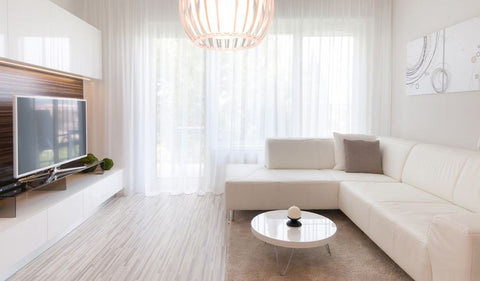Your home is what you make it, so make it feel bigger than it really is! We have some helpful tips to help you create a visually larger space. Don't let your small, quaint area feel cramped because of the wrong design elements!
Mirrors

They are great for checking yourself out, but mirrors also add decor to the room. Mirrors reflect the light that comes in and light can help expand the space of a room. Beyond reflecting light, you’re reflecting your surroundings. A strategically placed mirror gives the appearance of the room of continuing where it actually ends. Areas like hallways, areas opposite a larger space, and spots near windows are perfect locations to use mirrors to maximize the look and feel of a space.
Color
Color is one of the most powerful and effective tools for changing the appearance of a room. Color can vastly shrink or grow a space. For example: pale colors reflect & multiply light; when combined with natural light flowing in through windows this multiplication of light expands the room. In contrast, dark colors absorb and deflect light making an already small space feel more closed in.

Working within the same color pallet helps create continuity of space. The continuity of space is crucial to making a space feel large and open. The use of this type of monochromatic color scheme also allows for art to stand out against an unobtrusive backdrop.
Floors
Creating continuity within a space doesn't just apply to your walls. The use of contrasting colors & tone on the floor makes your mind form separations of space, sometimes creating a room that feels closed off. Keeping the flooring within the same color family makes the space visually open and aids the illusion of more space. Breaking continuity isn't always a negative, though. Separating a space can break up an area that's too large into two distinct areas instead of one awkward space.

This space utilizes a monochromatic color scheme throughout the entire room so while they're breaking other rules of making a small space appear large, the desired effect is still accomplished. Keep in mind, if some of these tips don't work for your particular setup, even utilizing just one of these elements makes a huge difference!
Less is More
Having fewer pieces of furniture and items to clutter your space visually expands the room. If items in your home are interrupting the traffic flow through your living space it effectively limits the amount of the room that can be seen and it changes how easily your guests can move through the area. If you can move through a space with ease the mind registers the space as having plenty of room.

One of the absolute worst items in a small home is a media cabinet! They stick out feet from the wall, right across from where you likely have a sofa and coffee table. Ditching the media cabinet in favor of wall mounting your devices is a no-brainer if you're trying to expand a small space. Then, if you choose to have something below your TV it's for decoration...not necessity.
Vertical Space

On the subject of wall mounting...don't ignore vertical space! The walls don't have to be just for pictures and art! Vertical space is extra square footage, perfect for shelving and storage. High placed shelving is makes for excellent storage without adding furniture at ground level. Minimalistic horizontal shelving is available in so many different styles, you're sure to find something that will work with your color scheme and decorative style.
So whether you're part of Tiny House Nation, in an apartment that's feeling a little cramped, or just trying to give one room a little redesign make sure you use these design tips to turn that small area from cramped to spacious!
